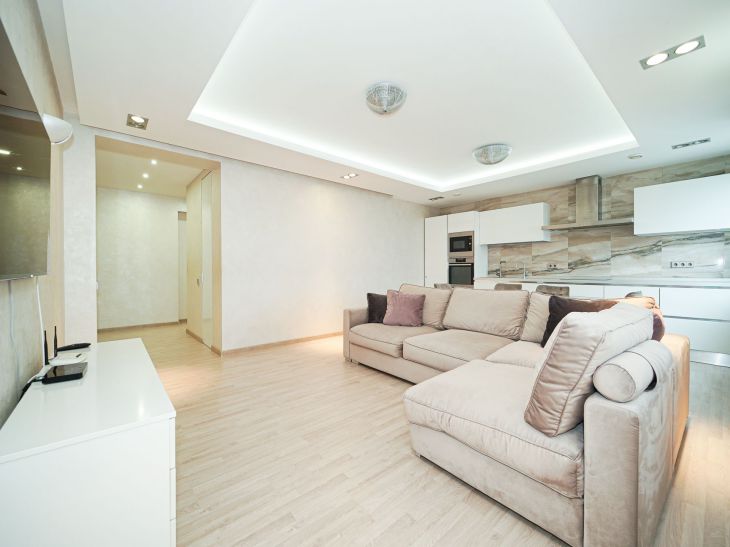A snow-white, perfectly smooth ceiling is your dream when renovating? You don’t need to hire a specialist to make it happen!
Refreshing your ceiling is easy - just follow our recommendations and learn how to paint a ceiling without streaks.
The key to success is careful preparation of the base, good paint and the right technique. Read our guide and learn the secrets of the professionals, says Yulia Tychino .

Why do we paint ceilings white? The benefits of a white ceiling
When you look up, have you ever wondered why almost every house or apartment has a ceiling painted white?
This "fifth wall" is a very important element in the design of the entire room, and in the end, the wide range of available solutions allows you to design it as you like. However, we still usually choose the classic white color, and this has many advantages.
• White color visually enlarges and illuminates the space, which is especially important in small interiors.
• White adds depth, so the ceiling appears further away than it actually is, making the interior appear taller.
• White is a versatile color, so a painted ceiling goes perfectly with other wall colors.
Painting the Ceiling Without Streaks - 5 Tips You Should Know
Painting a ceiling is a task you can probably handle on your own. But before you go shopping and start that long-awaited interior renovation, here are 5 tips to make the job easier.
Read on to learn how to prepare the base, what qualities a good paint should have, and how to paint a ceiling without streaks.
Careful preparation of the base
Contrary to what you might think, it is not the actual painting of the ceiling, but the proper preparation of the base that is the most important part of the entire operation.
If the surface is uneven and dirty, even the best paint will not turn the ceiling into a perfectly smooth, white sheet. If the ceiling was previously painted and now the coating is peeling and falling off, clean the surface thoroughly. Wash off greasy marks and stains with warm water and liquid or paint soap.
All of this also needs to be leveled, i.e. smoothed out, and in some cases, a new smooth surface needs to be made - it all depends on how your ceiling looks. If it is in very good condition or you are arranging a new room, then after cleaning the surface it is enough to prime it.
Priming - necessary or not
Priming involves applying an additional layer to the surface to increase adhesion and improve the opacity of the paint.
For this, you can use either a primer or a primer paint. What are the differences between these products and when should they be used?
The primer, depending on the type, can have a slightly milky color or be completely colorless. This is a product that is not applied to an already painted base. The primer is intended for new surfaces with high absorption capacity. When should you prime the ceiling before painting? You should do this if:
• putty and/or grout was applied to the surface, as these are very absorbent materials,
• the ceiling is covered with plasterboard, which also absorbs moisture well,
• you are renovating a house where the surface is being painted for the first time.
Primer paint, on the other hand, is useful if you are renovating a ceiling that has already been painted several times before.
Primer paint has slightly different properties than undercoat - it is white, evens out the substrate and cuts off the old color, so it effectively hides previous layers of paint and creates a background for the new one. Primer paint is ideal when, for example, you want to repaint the ceiling from a dark color to white.
Ceiling paint. Which one to choose
The next step is choosing the right paint - before you grab the first bucket off the store shelf labeled "ceiling paint," figure out what these products should have in common. Painting a streak-free ceiling starts with quality paint!
Latex paints are great because they are UV resistant and therefore create coatings that resist yellowing. This is very important, especially if you don’t want to have to redo the renovation in just a few months!
Painting technique is the key to success
The ceiling is ready, the paint is chosen - it's time to roll up your sleeves and grab a roller! Why a roller and not a brush? It is almost impossible to paint a ceiling with a brush without streaks, as the strokes remain visible on the surface.
The brush will come in handy for painting hard-to-reach corners, such as around a lamp. A large, wide roller with a telescopic handle will allow you to distribute the paint evenly, and when choosing the type and length of bristles, it is worth reading the manufacturer's recommendations for the selected paint.
A smooth, streak-free ceiling is the result of three clever methods used by experienced painters. Once you learn them, you will realize that the whole process is easier than you thought! Once you apply them, the result will definitely be impressive.
• The direction of paint application is very important. Professionals know this and apply the product in the direction of the light source, i.e. from the window into the room. This method allows you to eliminate all the imperfections, which in combination with matte paint provides a perfect, smooth and streak-free result.
• The wet-on-wet method, in simple terms, involves applying successive stripes of paint effectively before the surface begins to dry. Therefore, taking breaks at this stage is not recommended! Paint the ceiling in parallel, overlapping stripes with even movements in one direction.
• Careful handling of the roller is also important. Before you start painting, the roller should be slightly moistened with water and squeezed well to even out the absorbency of the bristles. When working, it is important to pick up the right amount of paint - always squeeze out the excess onto a mesh or paint tray.
Important! When preparing to paint the ceiling, pay attention to the temperature. To avoid streaks, it should not be too hot and dry - as the paint will dry too quickly.
On the other hand, high air humidity (above 80%) will increase the drying time of the paint. The optimal temperature for painting is considered to be 18-23°C.
Second coat - when to apply
Apply the second coat of paint only after the first one has dried well. Do not despair if you notice streaks somewhere right after the first painting, and do not patch them locally - this feature will definitely appear later on the ceiling.
Once the paint has dried, even everything out by applying another coat of paint – apply the product to the ceiling in the opposite direction to the first time. This is a secret of the professionals, allowing you to hide possible streaks.
Is your bedroom ceiling in need of an update? Or are you just getting your new apartment ready to move in?
Whether you are renovating or decorating a space from scratch, the ceiling is an important part of any decor!
To make it perfectly white, smooth, matte and beautiful, choose the right paint and follow our tips. Painting the ceiling without streaks has never been so easy!
Previously we wrote about how to choose the right flooring and not make a mistake.









